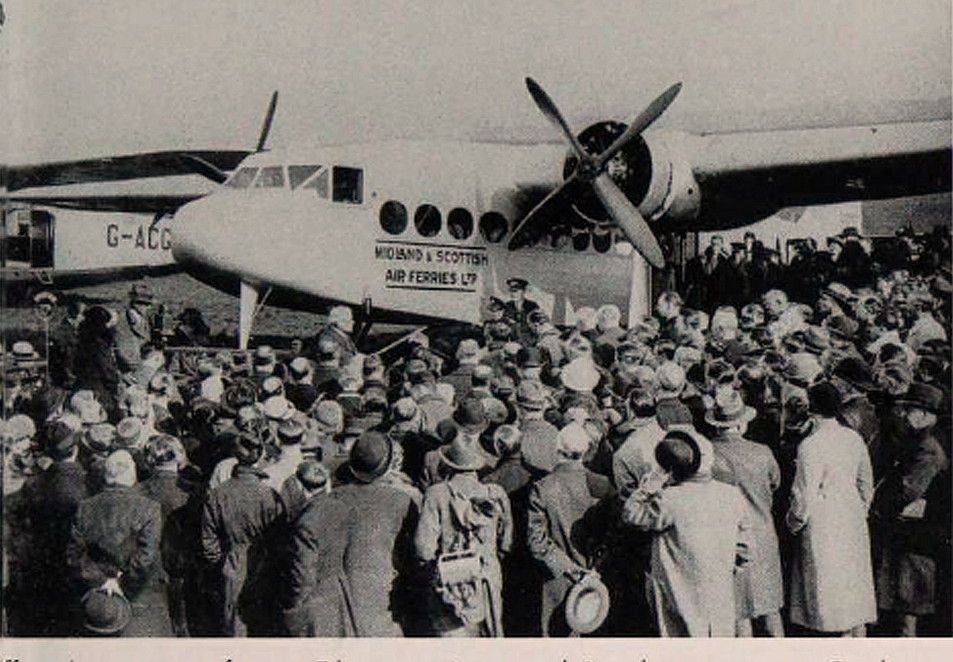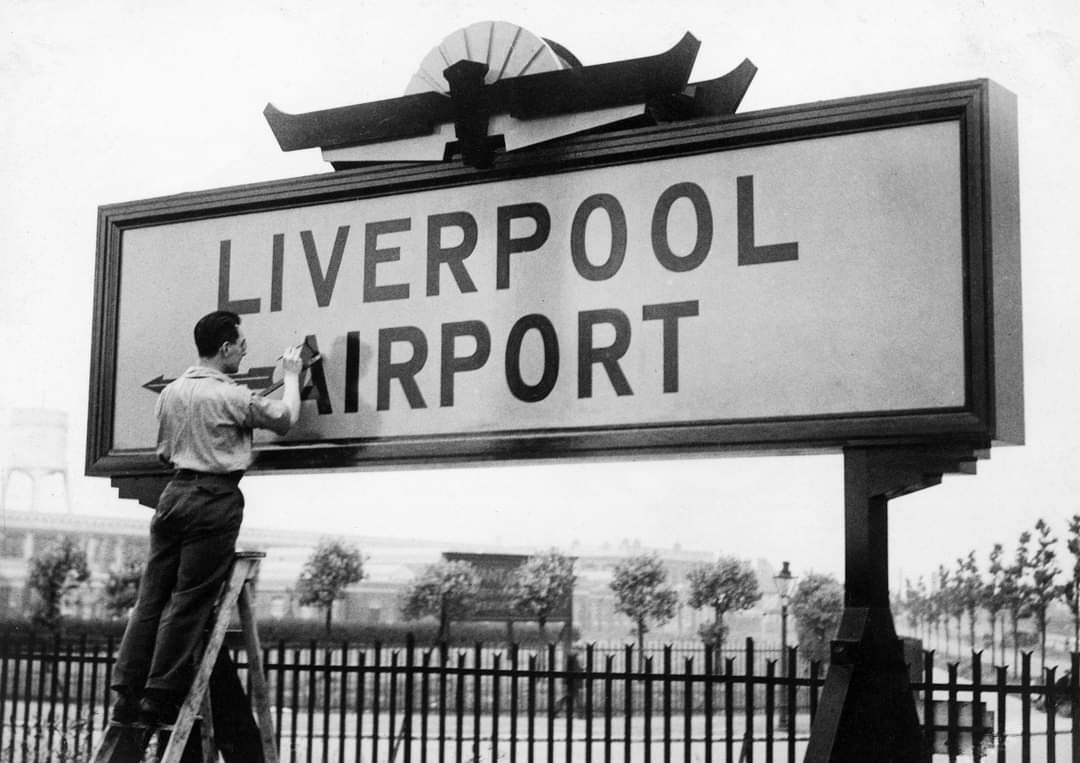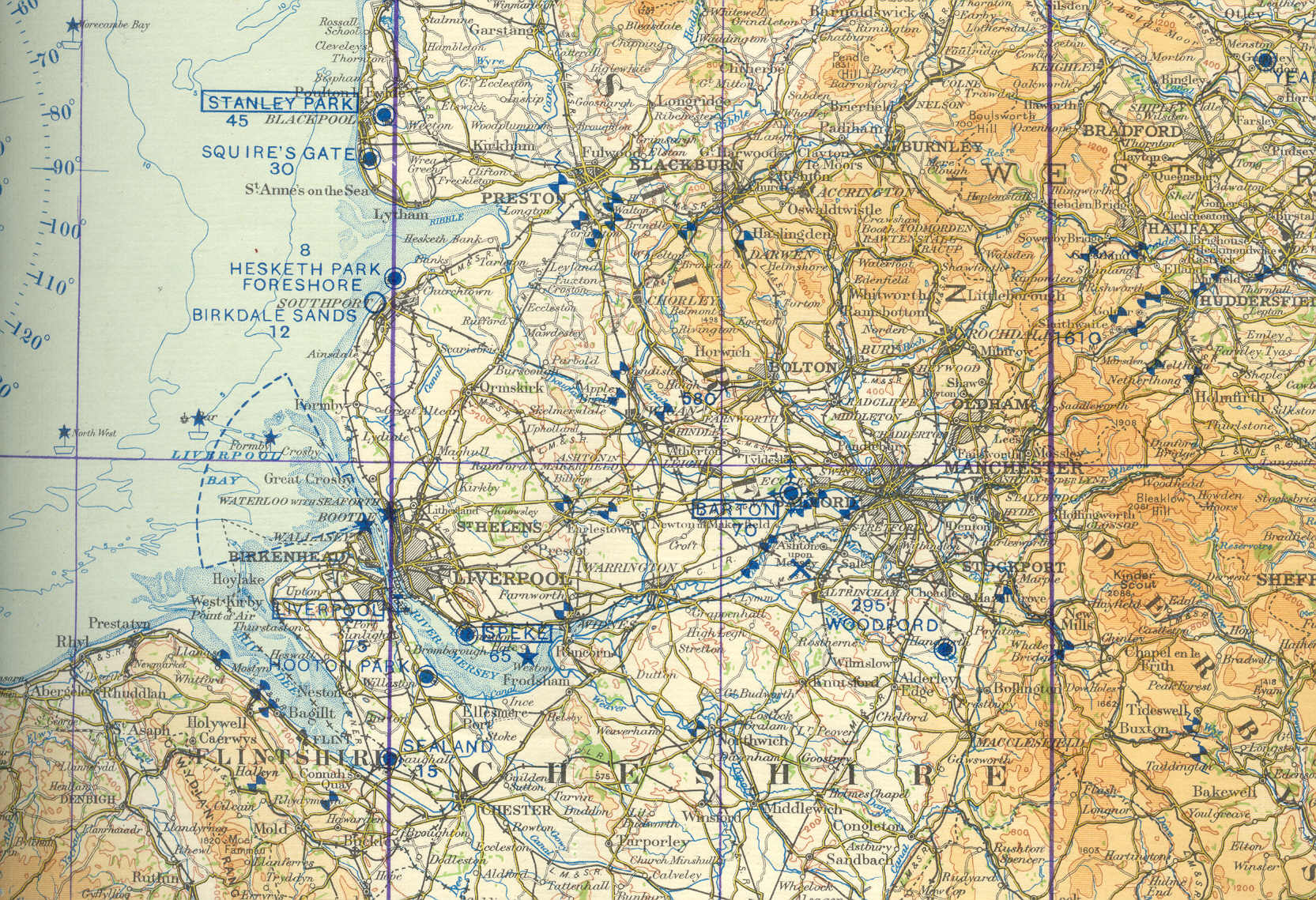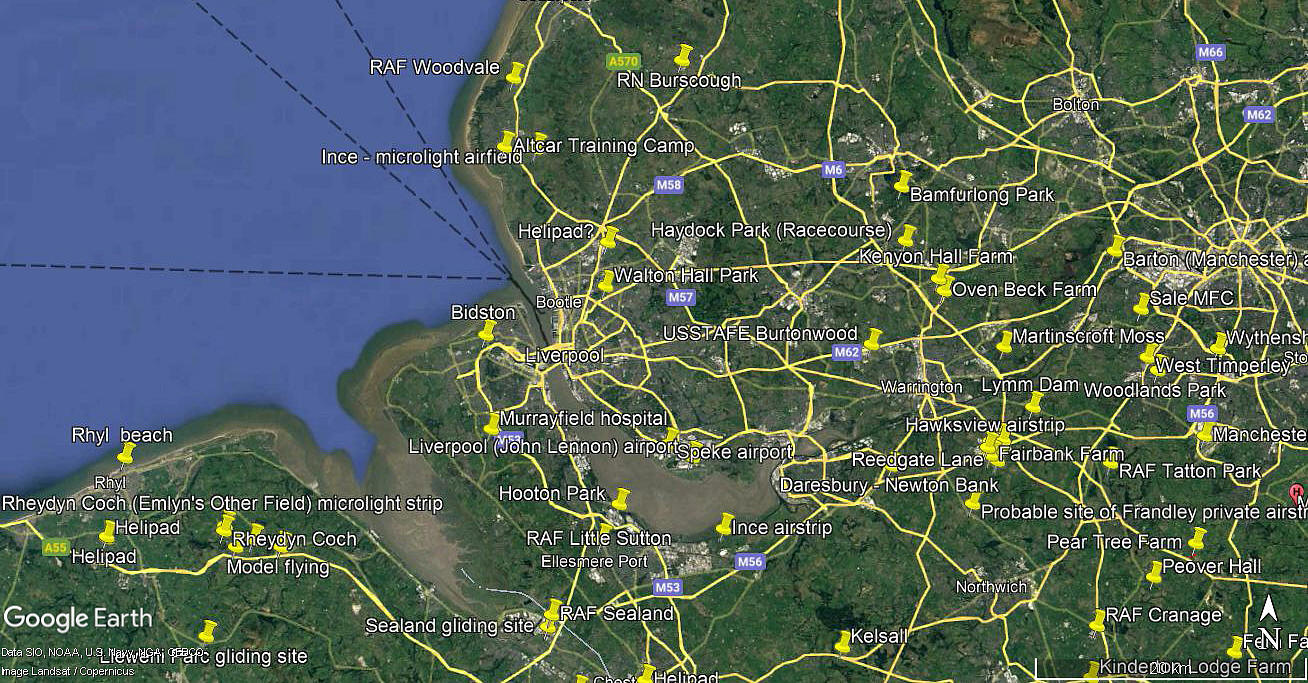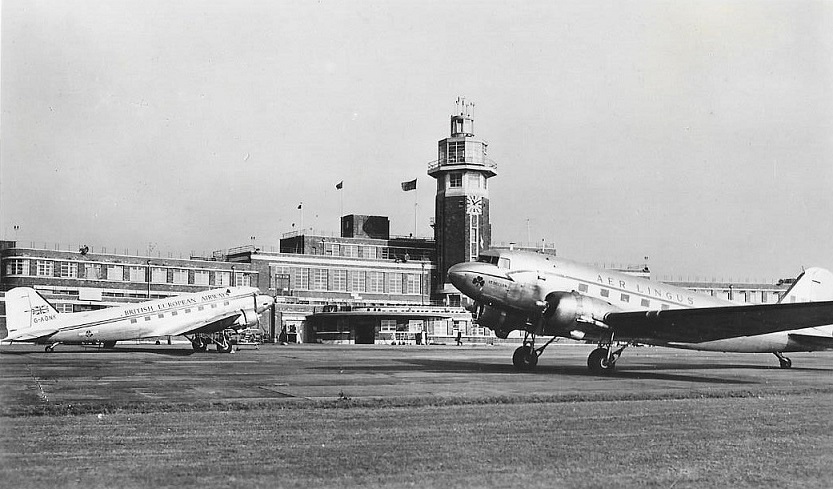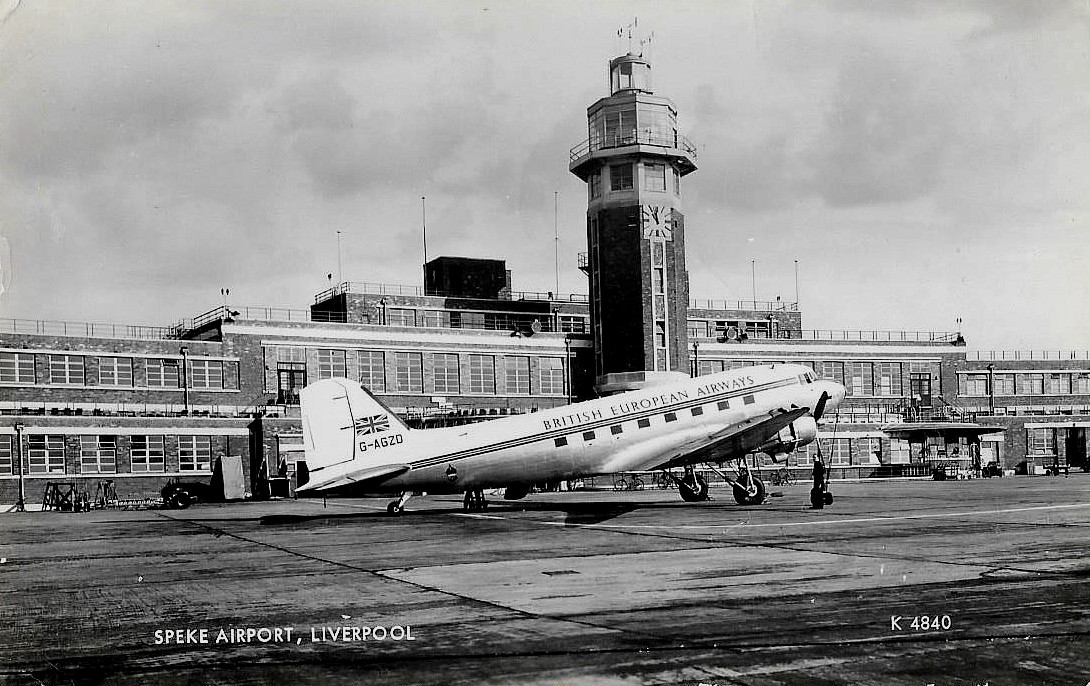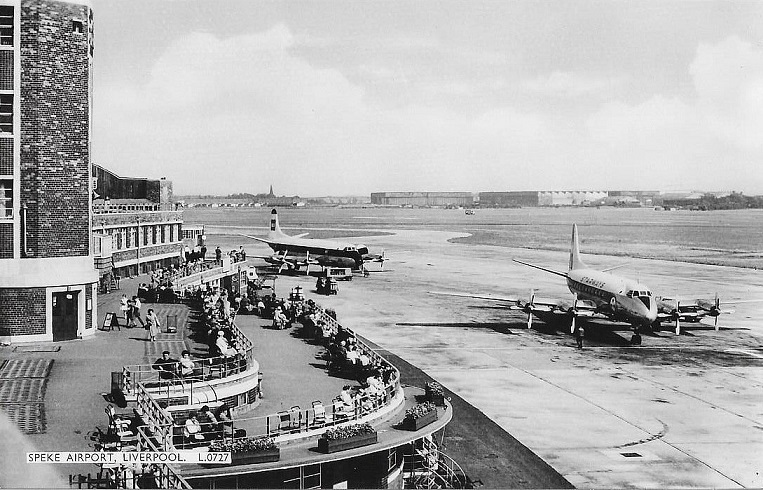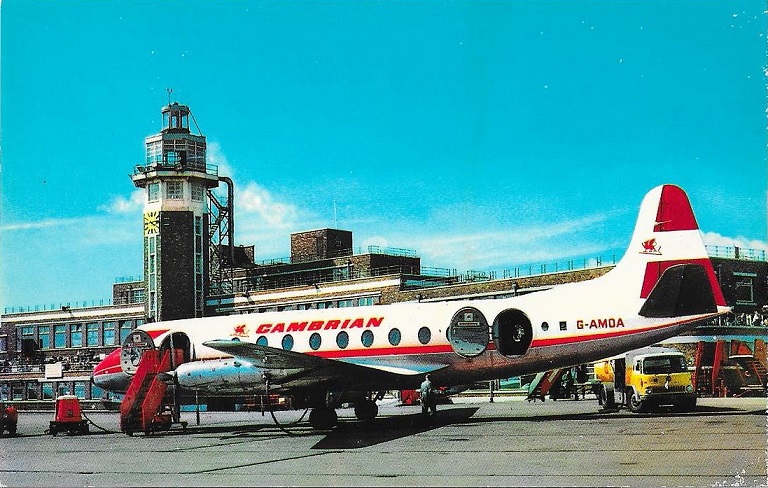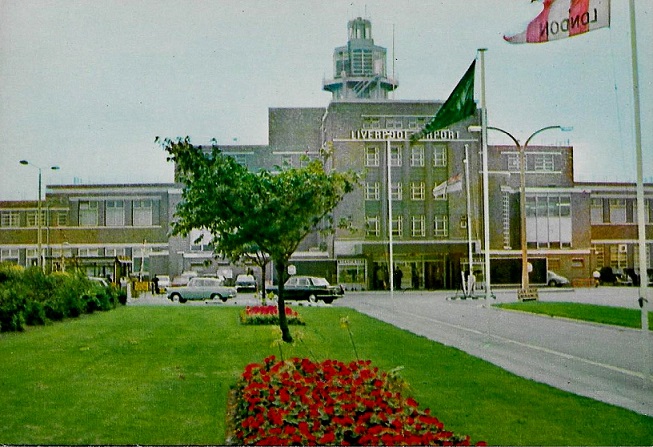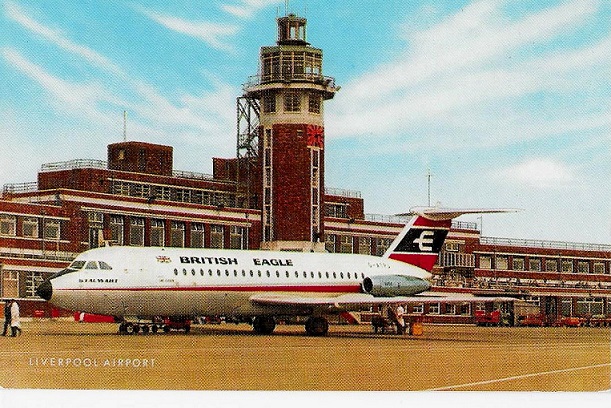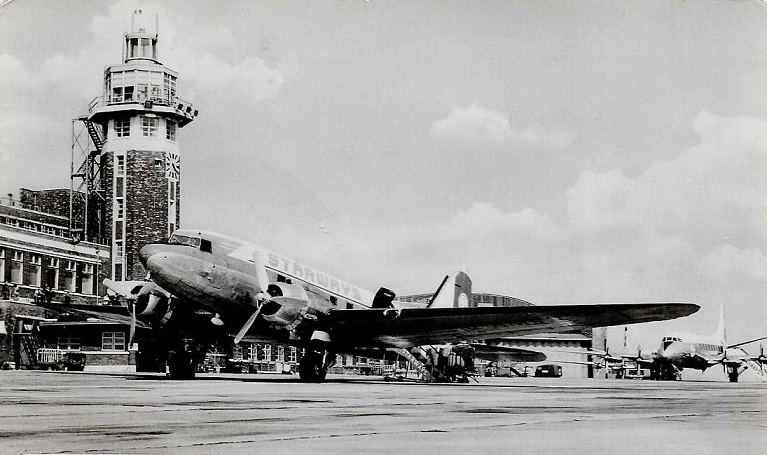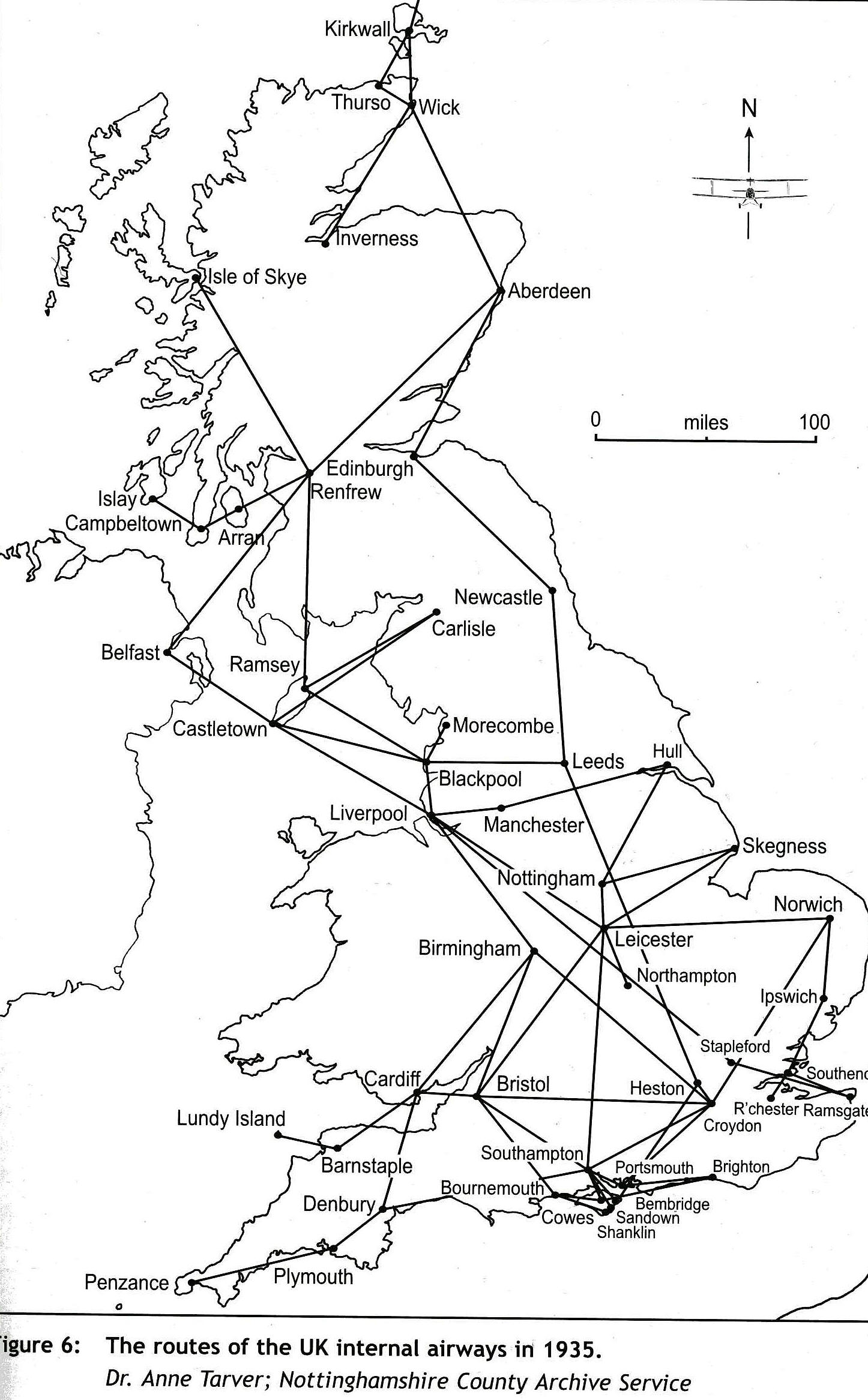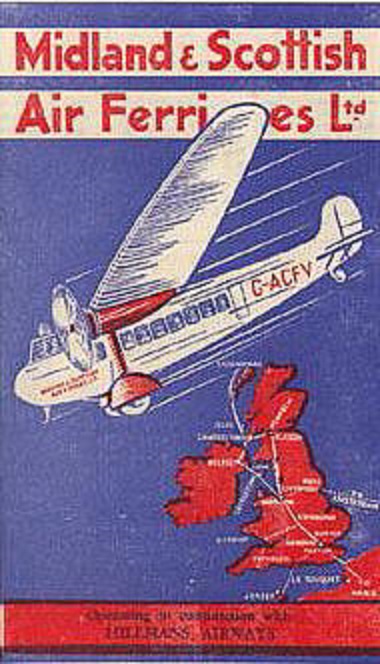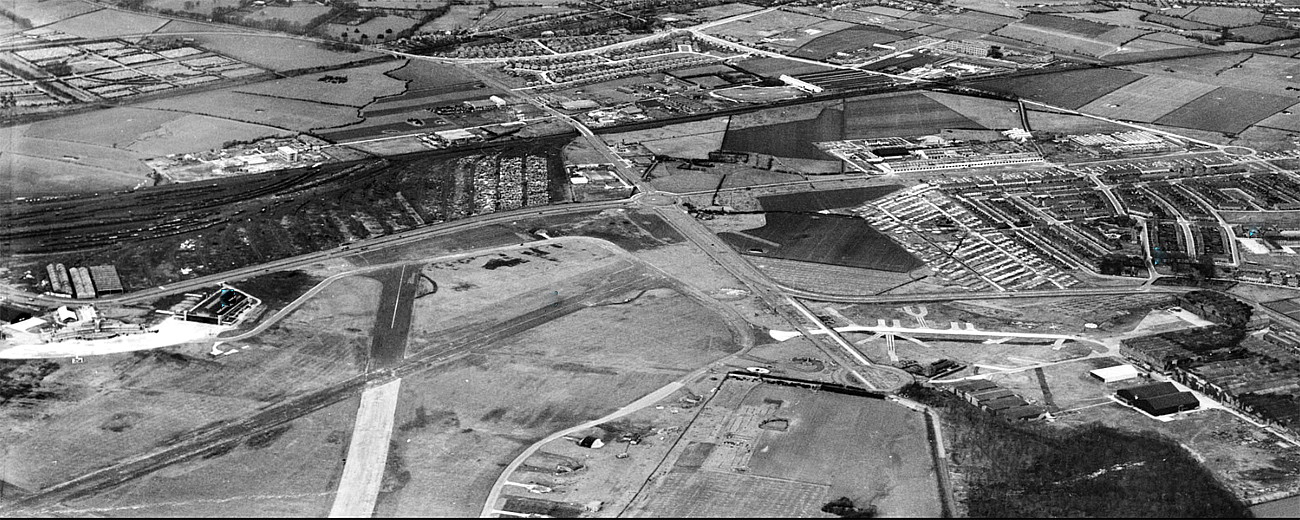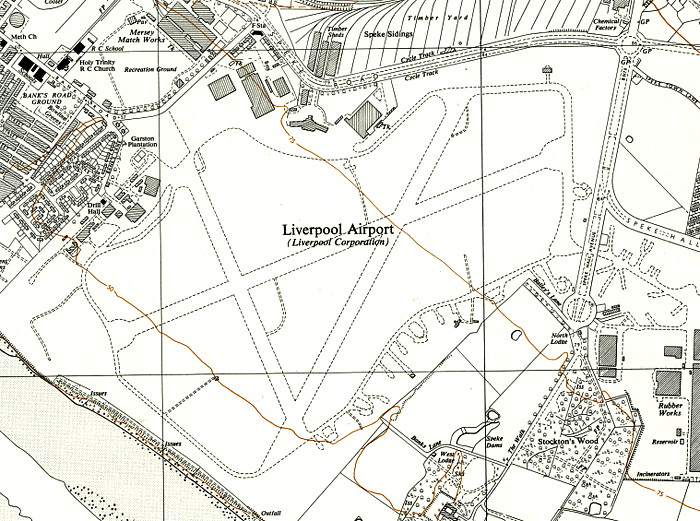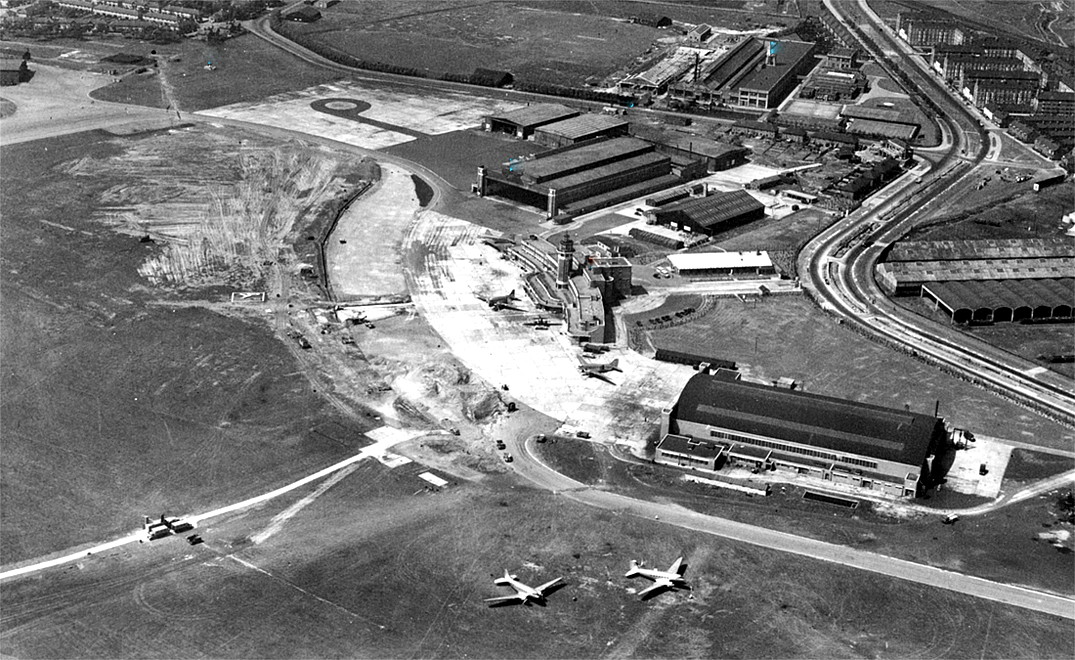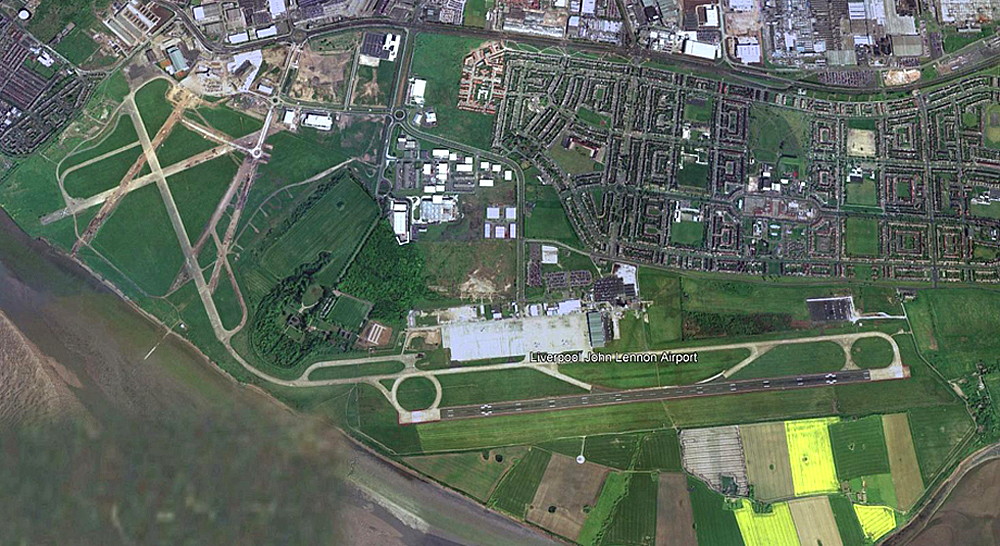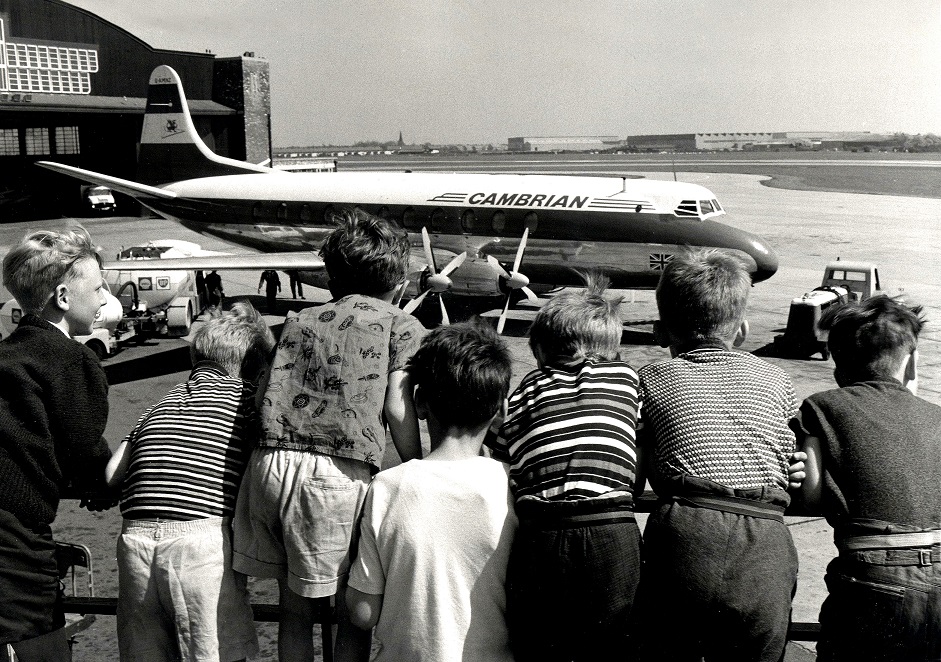Speke Airport
SPEKE: Civil regional airport later a partly RAF aerodrome in WW2
Note: The first rare picture from a postcard was kindly provided by Mike Charlton in August 2020, and shows a de Havilland DH84 Dragon of Railway Air Sevices making the inaugural air mail delivery. A bit of research appears to show that this was possibly in October 1934?
The third picture was obtained from Google Earth © and shows how SPEKE was closely related to the later LIVERPOOL airport
Operated by: 1933: The City of Liverpool
1965: Liverpool Corporation
Military users: Royal Air Force
Interwar years: 611 (West Lancashire) Sqdn (Hawker Harts, later Hawker Hinds)
WW2: RAF Fighter Command
308 (Polish), 312 (Czech) & 315 (Polish) Sqdns (Hawker Hurricanes)
776 Sqdn (Bristol Blenheims)
303 & 306 (Polish) Sqdns (Vickers-Supermarine Spitfires)
Fleet Air Airm: (1943) (Blackbourn Rocs, Skuas & Vought-Sikorsky SB2U Chesapeakes)
RAF 15 GCS
Although listed as being in charge of the Department of Civil Aviation and still being a civil airport the fact is that late in 1944 there were 728 RAF personnel stationed here plus 186 WAAFs. Hopefully I will find out what they were doing here and how much, if any, military flying activity took place during WW2.
This said it appears that 611 (West Lancashire) Squadron, now a RAF Auxiliary Squadron flying Spitfires set up here in May 1946, but, due to the amount of civil activity relocated to WOODVALE in July 1946. Here yet again, as asked so often in this 'Guide' who on earth in the RAF was making these decisions. Were these people really so stupid, or, being very cynical, did they have another agenda?
Note: The first picture was kindly provided by Mr Michael T Holder, a great friend of this 'Guide'. It shows the Avro 642/2M G-ACFV of Midland and Scottish Air Ferries. (They operated just the one of this sixteen-seater type). The picture, taken here on the 7th April 1934, was a ceremony to celebrate a new service linking Belfast, Glasgow, Liverpool and London. The third picture of the signwriter finishing off the airport sign was kindly provided by Mr Keith Jones. It is note dated but most probably from roughly the mid 1930s.
British airline users: Pre 1940: Air Commerce, Blackpool and West Coast Air Services, Crilly Airways, Hillman Airways, Imperial Airways, Isle of Man Air Services, Midland and Scottish Air Ferries, Railway Air Services, United Airways, Utility Airways
Post 1945: Air Commerce, Autair, BEA, Cambrian Air Services, Cambrian Airways, Dan Air, Dragon Airways, Giley Air Service, Isle of Man Air Services, Midland and Scottish Air Ferries, Starways, West Coast Air Services
Note: In the 1957 edition of 'The Aeroplane' directory, Starways were listed as a Scheduled Airline Operator. But, using their Douglas C-47 Dakotas for private charters for both passengers and freight.
Foreign airline users: Pre 1940: Aer Lingus, KLM Royal Dutch Airlines
Air freight: Pre 1940: Blackpool and West Coast Air Services
Car ferry: Post 1945: BKS
Charter/air taxi: Pre 1940: J Blake & Co
Post 1945: Airmotive (Liverpool), Cumberland Aviation Services, Dragon Airways, Federated Air Transport, North West Air Services, Skytravel, Steiners Air & Travel Services, Wirral Airways, Wright Aviation
Note: This picture from a postcard was kindly sent by Mike Charlton.
This Dragon Rapide was first registered to Scottish Airways at RENFREW on the 28th July 1939, and they operated it throughout WW2 until the 31st January 1947. It is a myth that all civilian aircraft were either impressed or forbidden from flying in the UK during WW2. Civil services were much in evidence in Scotland, especially for providing services to the islands. It then went to BEA (British European Airways Corporation) until the 7th June 1948 when it went to Gibraltar Airways during 1949.
It appears Airmotive acquired G-AFOI from the 28th June 1950 until the 28th May 1952 and based it at SPEKE. It was then sold to Handley Page (Cricklewood), who presumably based it at RADLETT as a company 'hack' from the 5th June 1952 until the 20th March 1958, when it was declared PWFU (Permanently Withdrawn From Use).
Flying club/school: Pre 1940: Liverpool & District Aero Club (From 1934)
Post 1945: Cumberland Aviation Services, De Havilland (Chester) Flying Club, Eagle Aero Club, Federated Fruit Company Flying Club, Liverpool Flying Club, Merseyside and North Wales Flying Club, Royal Artillery Aero Club
Note: In the 1957 The Aeroplane directory, the De Havilland (Chester) Flying Club were listed as being based here.
As were the Merseyside and North Wales Flying Club. Can anybody kinfly provide advice regarding the aircraft types both these Clubs were operating?
What seems quite extraordinary is that, in this directory, the Royal Artillery Aero Club, operating two Auster J/1N Autocrats and one Miles M38 Messenger, were based both here and at CHRISTCHURCH in HAMPSHIRE. It appears that flying instruction and maintenance were entrusted to the Federated Fruit Company Flying Club, but they in turn were being basically run by Wright Aviation.
1959 ‘snapshot’. West Lancs Flying Group
Maintenance: Post 1945: Airwork
Manufacturing: WW2: Rootes Securities, Lockheed Overseas Corporation
Pleasure flights: Post 1945: Cumberland Aviation Services, North West Air Services
Note: The area view is from my Google Earth © derived database.
Location: Adjacent to (NW) of LIVERPOOL AIRPORT now JOHN LENNON AIRPORT
Period of operation: Used from 1930, officially opened in July 1933, (but others say June 1937!), to the 1980s
Note: These maps are reproduced with the kind permission of Pooleys Flight Equipment Ltd. Copyright Robert Pooley 2014.
Runways: According to Neville Doyle in his book The Triple Alliance it seems the initial ‘landing runs’ in 1933 were a maximum of 914 and a minimum of 732 metres. By 1938 he states these distances had been increased to 1372 and 1006. Another source states that the maximum landing run available in 1933 was 1280 grass
WW2: 04/22 1280x46 hard 08/26 1518x46 hard 17/35 942x46 hard
1959: 04/22 1276x46 hard 08/26 1561x46 hard 17/35 973x46 hard
1965: 08/26 1715x46 hard 17/35 973x46 hard
NOTE: The E/W 2286 metre runway that is now used by JOHN LENNON AIRPORT was originally built as part of SPEKE to enable larger aircraft to operate, such as BEA Tridents. At one point in the early 1980s, a 747 diverted here from MANCHESTER causing utter chaos as the interim terminal, in fact one of the old hangars, hadn't been fully completed.
A MIKE CHARLTON GALLERY
These pictures from postcards were very kindly provided by Mike Charlton who has an amazing collection. See - www.aviationpostcard.co.uk
First picture: I have no idea if this picture was taken before WW2 or after? I suspect before WW2? If anybody can kindly offer advice, this will be most welcome.
Second picture: Being in colour, presumably post WW2? But, note that the only aircraft in view is a DH89A Dragon Rapide.
Third picture: In the foreground is an Aer Lingus C-47 Dakota, and beyond the BEA (British European Airways) C-47 Dakota 3 G-AGNK. Typically this Dakota led a varied career being registered to BOAC from the 14th February 1945 until July 1949. Field Aircraft Services then registered it for just two days - the 4th July until the 5th July 1949. It then went to an operator in Manchester, from the 25th July 1949 until the 1st April 1951 - but I cannot read the handwritten entry. Can anybody kindly offer advice?
It was then registered to BEA (British European Airways) from the 2nd April 1951 until the 26th May 1961. Passing immediately to Channel Airways at SOUTHEND it served with them until the 1st March 1970, when it was PWFU (Permanently Withdrawn From Use). I find it interesting that so many of the BEA Dakotas were purchased second-hand.
Fourth picture: The Douglas C-47 Dakota 4, G-AMRB. This Douglas C-47 Dakota 4 served with Starways from the 8th March 1952 until the 28th March 1956 when it crashed on a positioning flight from SPEKE to RENFREW at Largs, killing all three crew members. Pilot error was given as the cause.
Fifth picture: This picture poses a few questions. A type which I love - it's an age thing of course. Starways registered it as a Skymaster DC-4. But, Douglas never, as far as I know, gave the name 'Skymaster' to their DC-4 models. This name was given by the USAF for their Douglas C-54s. And, is so often the case for airliners of that era, it had a chequered career.
After a bit more research, and help, it appears that this DC-4 was delivered new to National Airlines in the USA as N33682 in April 1946. In 1952 it sold to Resort Airlines who leased it to Trans Continental Airlines until 1955 when it went to Great Lakes Airlines. A rather suspect that, as seen in this picture, G-APEZ is basically wearing the colours of one of these U.S. airlines.
In the UK Starways operated it from the 23rd September 1957 until the 31st December 1963. It then passed to Aviation Overhauls, also at Speke, from the 3rd January 1964 until the 18th January 1965. It then went to Aviation Charter Enterprises (ACE Freighters), presumably based at COVENTRY (?) from the 29th of April 1965 until the 12th August 1970 when it was PWFU. (Permanently Withdrawn From Use). Another source says it was PWFU at COVENTRY in May 1967.
Sixth picture: Here again, another 'Dak' with an interesting history. After becoming 'civilianised' this Dakota G-AGZD was originally registered to BOAC (British Overseas Airways Corporation) at WHITCHURCH near Bristol from the 27th February 1946 until the 19th August that same year. It then immediately transferred to BEA, (British European Airways Corporation) and served with them until the 26th July 1960.
Ownership then passed to Channel Airways (SOUTHEND) from the 28th July 1960 until the 3rd May 1963. But here comes the interesting bit. It appears that for just eight days, from the 6th May until the 14th May 1963 it was registered to BOAC Associated Companies before going to the Bahamas.
Seventh picture. Apart from the BEA Viscount, the Starways 700 Series Viscount in the foreground must be of more interest. Without too much doubt this is G-ARIR, ex-Air France. Starways only operated two Viscounts from 1961 until 1964, during which time they were absorbed into British Eagle.
Starways it appears, operated G-ARIR, a Viscount 708, from the 22nd March 1961 until the 19th November 1963. It then went to France for a short period before returning to Alidair, based at EAST MIDLANDS, from the 28th November until the 31st January 1984. It then seems it was registered to Hards Travel Service Ltd in Solihull from the 21st February 1984 until the 26th November. It then went to Zaire.
Eighth picture: This Vickers 701 Viscount, G-AMOA, was originally registered to Vickers from the 23rd May 1952 until the 23rd March 1953, and one has to wonder why? One possibility, I suppose, is that registrations were issued to aircraft destined for the production line.
BEA (British Eurpean Airways Corporation) then operated it from the 28th March 1953 until 28th December 1963. It then went to Tradair, based at SOUTHEND, from the 21st February 1964 until the 4th January 1966, when Cambrian Airways, address GLAMORGAN (RHOOSE) AIRPORT, purchased it and operated it from the 18th January 1966 until the 6th May 1971. It was then PWFU, (Permanently Withdrawn From Use).
Ninth picture: Here again, two Vickers Viscounts on the apron. The first being a Cambrian Airways example, and beyond a British Eagle Viscount. British Eagle operated six Viscounts in 1964, reducing to four in 1968. It therefore seems reasonable to suppose this picture dates from the mid to late 1960s?
Eleventh picture: I cannot pin this down, but suspect it was taken around 1968 or soon after? Probably a BAC One-Eleven 300 Series of which they operated five? British Eagle were one of the most successful British independent airlines, operating from 1948 until 1968. But typically beset by a large number of operational difficulties along the way.
Twelth picture: How fitting for SPEKE, a Starways Douglas C-47 Dakota. A type that epitomises the post WW2 era when fledgling airlines were being established around the UK, including the two major national airlines, BEA and BOAC who operated large numbers of this classic airliner. Could that be the Starways Viscount G-ARIR seen beyond?
NOTES: The sheer amount of myth, legend, misinformation and even downright lies which spreads throughout every aspect of British aviation history is quite staggering – so much so it once made me seriously consider giving up producing this 'Guide'. But then I realised this is probably exactly the reason why a 'Guide' is needed! For example I found this information: In 1931 Blackpool & West Coast Airlines started operating a Liverpool-Blackpool-Isle of Man service from here. In those early days it is said that a farm-house was the ‘terminal’ and farm outbuildings were used as workshops.
However, if it is correct that Blackpool & West Coast Air Services Ltd were first registered as a company on the 3rd April 1933 and operated their first services; Liverpool (SPEKE) – Blackpool (SQUIRES GATE) – Isle of Man (RONALDSWAY) on the 3rd July 1933 (some say it opened on the 1st July 1933) to coincide with the opening of SPEKE, which strikes me as very probable (?), then the previous account is obviously in question.
The initial fleet operated by Blackpool & West Coast Air Services was, it appears, the DH84 Dragon G-ACGU plus two DH83 Fox Moths, G-ACFC and G-ACFF.
FLYING CIRCUS VISITORS
Venue, in June 1932 for the Modern Airways, (The Crimson Fleet), ‘Tour of the UK’
Venue, (11th June 1932), for Alan Cobham’s National Aviation Day UK display Tour.
Note: This route plan by courtesy of Dr Anne Tarver, Nottinghamshire County Archive Service
1930s AIRLINE OPERATIONS
MIDLAND and SCOTTISH AIR FERRIES
On the 6th April 1934 Midland and Scottish Air Ferries started a service to MAYLANDS (ESSEX) to collaborate with Hillman’s Airways and their service to Le Bourget (Paris). The inaugural flight to London landed at HESTON for some obscure reason, but probably to impress the ‘nobs’ on board, including Ramsey MacDonald the then Prime Minister! John Sword had intended to use CROYDON as the MSAF terminus but decided against it when he found that Railway Air Services were to use CROYDON. SPEKE therefore became a ‘hub’ connecting Glasgow, Belfast and the Isle of Man to London, Paris and beyond. For this information I am indebted to Neville Doyle and his excellent book The Triple Alliance.
Neville Doyle goes on to say: “The plan was to use the Avro 642 and the Avro X on the London to Liverpool section. Airspeed Ferries over the water to Belfast and Dragons between Liverpool and Glasgow, but in practice there was considerable variation. Initially a call was made at Birmingham but this was soon dropped in favour of Blackpool”. To pick the bones out of this for the purpose of this Guide: Belfast was ALDERGROVE, Glasgow was RENFREW, and the Isle of Man was probably CASTLETOWN. Birmingham was CASTLE BROMWICH and Blackpool was STANLEY PARK.
It appears the first regular connecting service from MAYLANDS got into a right ‘two and eight’ as ‘Ted’ Hillman might well have called it. “The regular service began on April 9th with Capt. Anderson leaving Maylands at 8.10 am in Fox Moth G-ACCB to arrive at Speke at 10.05 am (without calling at Castle Bromwich), only to find that Nigel Perry in the Ferry G-ACFB had already left Speke for Belfast, via Hooton! Southbound, the Avro 642 was scheduled to fly the whole distance from Aldergrove to Maylands but engine trouble developed at Speke and Squadron-Leader Malet had to continue in the Dragon G-ACDL almost an hour late, calling at Castle Bromwich on the way. And to add to the day’s tribulations, the second southbound machine, Avro X G-ACGF did not leave Speke until 4.45 pm.”
RAILWAY AIR SERVICES
From the 7th May to the 29th September 1934 Railway Air Services operated the DH.84 Dragon G-ACPX between here and Plymouth (ROBOROUGH) via Birmingham (CASTLE BROMWICH) – Cardiff (PENGHAM MOORS) and Teignmouth (HALDON).
CRILLY AIRWAYS
In 1936 Crilly Airways based at BRAUNSTONE (Leicester Airport), were linking SPEKE with, for example, Bristol (WHITCHURCH), DONCASTER, Hull (HEDON), Northampton (SYWELL), Nottingham (TOLLERTON) and Norwich (MOUSEHOLD HEATH).
UTILITY AIRWAYS
Even a brief study of the history of Utility Airways will most probably reveal, (how shall I say?), the seedier aspects of British aviation history? Let’s say falling short of being professional. The only proof I have found of Utility Airways operating a ‘scheduled’ service is in May and June 1938 when a four times daily service operated between HOOTON and SPEKE. This soon became an ‘on request’ service. Hardly the sort of enterprise I’d associate with an organisation proclaiming itself as being an ‘Airways’operation. This said it is of course the antics of just such companies that provide the rich matrix of aviation endeavour that make any study of our aviation history so fascinating. I often try to imagine who were the people working for and, (being a private pilot myself), especially those that flew for such companies - and what were their personal histories and aspirations?
A MOST BIZARRE ACCIDENT
I would like to quote a couple of paragraphs from David Luff, in his excellent biography, Amy Johnson - Enigma in the Sky. Simply because it serves to illustrate aspects of what was going on in those days.
"By June 1936 the Mollisons, (my note - Amy Johnson was now married to Jim Mollison), had dropped the idea of a round-the-world flight when they failed to buy back the Comet they had sold to the Portugese." (My note: This was the DH.88 Comet Racer Black Magic (G-ACSP) in which they failed to compete the course in the famous MacRobertson race from England to Australia).
"However.....the wealthy South African industrialist, I. W. Schlesinger announced that he was prepared to put up £10,000 prize money to sponsor an air race from the UK to South Africa, which would be run on similiar lines to the MacRobertson. Its aim was to celbrate the opening of the Johannesburg Empire Exhibition, which was due to commence in September, and at the same time give the British aircraft industry a chance to display its wares."
"It was an ill-timed event, for Germany was beginning to flex its military muscle by occupying the Rhineland earlier in the year, and as a consequence the rearmament of the RAF had now become a priority. Futhermore, the fact that entries had been restricted to those flying British machines meant that there were eventually only nine competitors." (My note: The race started at PORTSMOUTH (HAMPSHIRE)
They both realised that the only hope of success in this race was to fly, seperately, one of the new Percival Mew Gulls - and none were available.
A TURN OF EVENTS
On the 19th September 1936, whilst preparing to compete in the Schlesinger air race from Portsmouth to Johannesburg, the famous pilot Tom Campbell Black was killed in a bizarre accident. Sitting stationary whilst waiting to take-off in his Percival Mew Gull Miss Liverpool G-AEKL, he was hit by the RAF Hawker Hart K3044, the propeller of which sliced through his cockpit and nearly split the aircraft in half. He survived the accident but died shortly after.
Ten days before the start of the race Amy Mollison (nee Johnson) announced that she was prepared to compete in Miss Liverpool if Percival could repair the aircraft in time. They couldn't do this, but Amy was severely criticised for trying to 'cash in' on Campbell Black's death - even though she insisted she wanted to honour his memory. That was how the 'press' worked then, and still does of course - never let fact or truth get in the way of a 'story'.
A MICHAEL T HOLDER GALLERY
A NEW TERMINAL
Construction of the airport took place between 1930 and 1933 but the large innovative Art Deco style terminal building didn’t open until 1939.
By the outbreak of WW2 SPEKE was claimed to be the second busiest airport in the UK. SPEKE probably closed in or around 1970 after the ‘new’ Liverpool airport was constructed to the south and east and opened in 1966 on an entirely separate site.
In the mid to late 1930s a few towns and cities realised the importance of air travel and sought to proclaim their support by building quite remarkable facilities. Liverpool is an excellent example because at their SPEKE airport they built a Art Deco style terminal and hangar which opened in 1938. However, it should be appreciated that by then SPEKE had developed to be possibly the second most important domestic UK ‘air junction’ or ‘hub’ as we’d call it today. Also in 1938 it is claimed there were over one hundred private aerodromes, about 25% owned and operated by aircraft manufacturing companies?
A BIT OF WW2 HISTORY
During WW2 SPEKE was used by all three services and, in addition, even before WW2, military aircraft were shipped in from the USA for RAF use and were assembled and test flown here.
Perhaps it is interesting to reflect that before WW2 the British government had realised that we could not cope on our own, by relying on only British companies to produce enough aircraft for WW2. A Commission was sent to the USA to explore various possibilities despite an outcry from the SBAC. And remember, this was long before the now notorious ‘Lend-Lease’ agreement. In 1938 Lockheed set up an assembly plant at SPEKE which eventually produced most of the 2000 Hudsons used by the RAF.
Perhaps the biggest problem I’ve had in researching this Guide is coping with the chronology and discovering that nearly all of my perceptions regarding aviation history have been blown out of the water. For example the Imperial Airways Empire Class flying boats which I’d always felt must have been operating for about thirty years at least such was their impact, (although any idiot can work out that only roughly twenty years separated the end of WW1 and the start of WW2). To discover this hugely admired and illustrious period lasted just three years or so was quite a surprise, although these briefly magnificent aircraft did keep operating during most of WW2. In itself another major surprise!
In a similar vein the bespoke, highly acclaimed and unique terminal building at SPEKE seems to be iconic for pre-war, (WW2), airport architecture, so much superior to that gloom-ridden pile at CROYDON for example which itself was intended to be our best effort to show the world how excellent we were at the cutting edge of aviation architecture. However, during a brief period in the later years of the 1930s it seems British airport architecture was often leading the world in many respects and SPEKE was a fine example along with ELMDON, GATWICK, (the ‘Beehive’), and RAMSGATE airports. It now appears this terminal opened in November 1938, just ten months before the British Government declared war on Germany. Perhaps needless to sayI have found other reports claiming it opened in 1939.
ROOTES SECURITIES
In WW2 Rootes Securities were building Blenheims, Beaufighters and Halifax bombers at both SPEKE and BLYTH BRIDGE/MEIR in STAFFORDSHIRE. The Lockheed Aircraft Corporation, (said to be the Lockheed Overseas Corporation by some), had opened the British Reassembly Division for Hudson types, later becoming No.1 Aircraft Assembly Unit under the MAP (Ministry of Aircraft Production). They also handled Bostons, Wildcats, Avengers, Hellcats, Corsairs, Bermudas, Kingfishers, Helldivers, Reliants, Seamews and the Argus type
I will readily admit to not doing any proper sums but it does seem the north-west of England was the major ‘power-house’ for bomber aircraft production and/or assembly in WW2. Over 2500 Blenheim variants were produced by Rootes Securities here alone between 1937 and 1941. This was followed by 1070 Halifax bombers from 1941 to 1945. If you couple this with what Avro were doing in the region, (regarding Lancaster production especially), plus Wellington production at Blackpool for example, can there be any doubt?
THE POST WAR ERA
On the 1st July 1950 BEA started the first in the world scheduled helicopter service between SPEKE and Cardiff, (RHOOSE). With two more calls - see Cambrian Airlines history
In the 1950s Airwork did a lot of work on Canadair Sabres for the RAF here. I was a spotter from about the age of eleven, and Air Pictorial was my bible, the basis I suppose of my mistaken belief that I knew a thing or two about British aviation history? It was only when I first visited the excellent museum RAF COSFORD in 2008 that I remembered that the RAF were once flying North American F-86 Sabres, albeit examples built by Canadair. One example still exists, on display in the museum at COSFORD.
AIRLINE SERVICES
In 1959 BEA offered services from SPEKE to the Isle of Man (RONALDSWAY), Belfast (NUTTS CORNER) and, so it is claimed, Manchester (RINGWAY). Presumably this should read, a Manchester service to the Isle of Man and Belfast calling in at Liverpool?
Aer Lingus served Dublin and Cambrian Airways served Jersey via Cardiff (RHOOSE) and Bristol (LULSGATE). Starways operated a scheduled service to London, (originally to NORTHOLT but later to London Airport now HEATHROW), plus inclusive tours to the continent, or Europe as we’d say today.
Federated Air Transport had Avro Ansons and DH Dragon Rapides available for charter work and North West Air Services operated a DH83 Fox Moth for joy-rides.
GA flying club activity was conducted by the Merseyside and North Wales Flying Club.
In April 1960 BKS aquired by a lease agreement the Bristol Freighter G-AILW. This aircraft operated a car ferry service to Dublin. It appears that BKS had high hopes for this service but it appears it only operated in 1960?
A VERY COMPLEXICATED STORY
When Wright Aviation transferred their operations from HOOTON PARK in 1950, according to the North West Air News web-site, they were; "...engaged on charter work, club flying and Territorial Army Co-operation flying. During the year twins were acquired, the Dragon Rapide and Miles Gemini being used almost entirely on charter and Territorial Army Co-operation flying."
"A second Dragon Rapide was acquired on lease from Starways for brief periods during 1953, and in the summer Wright Aviation entered into an agreement with the Federated Fruit Company whereby Wright would operate a fleet of aircraft on Federate's behalf." This would be Federated Air Transport and the Federated Fruit Company Flying Club, who were also tasked with looking after the visiting aircraft of the Royal Artillery Aero Club - their other base being CHRISTCHURCH aerodrome in HAMPSHIRE.
Having discovered this in April 2018 it now appears the picture is muddied. "Wright Aviation ceased operations by early November 1953, and the operation of Liverpool Flying Club was transferred to Dragon Airways." As far as I can see, the fate of the Federated Fruit Companies twin flying enterprises is yet to be explained.
It would appear that the fleet Dragon Airways 'inherited' was: The two DH89A Dragon Rapides G-AHPT and G-AIBB, the Miles M65 Gemini 1A G-AKEM, and the Percival P44 Proctor V G-AIAA. Plus the Austers G-AGVI (Auster 5 J/1), G-AHAK (Taylorcraft Plus D) and G-AIBZ (Auster J/1N Alpha). Last but not least three Miles Hawk Trainer 3s - G-AIZL, G-AKRM and G-ALOG.
DRAGON AIRWAYS
Here again, information found on the North West Air News web-site. "On 16th January 1954, Dragon Airways was registered as an airline company by Captain Maurice A. Guinane of Pwllheli, Mr Donald H Tod and Mr Harold R. Bamberg (at that time also the Managing Director of Eagle Airways)." My note: Harold Bamberg, I'm fairly certain, later went on to be the Managing Director for Cunard Eagle based at HEATHROW.
When Dragon Airways moved their operation to SPEKE they also took over the operation of the Liverpool Flying Club, "...which was flying a mixed fleet of Austers and Miles Hawk Trainer. From Wright Aviation in January 1954 a Dragon Rapide and Miles Gemini were added to the single Dragon Rapide already operated." See what I mean about the complexity? "The company operations revolved around pleasure flights, air taxi work and also some flying training."
"In May 1954, Dragon Airways applied to the A.T.A.C. for permission to operate seasonal scheduled services from Liverpool and Manchester to Pwllheli using Dragon Rapide, Gemini and Auster aircraft initially, and later with Twin Pioneer aircraft." This latter type being mooted I find quite a revelation! "Approval for the operation was quickly received, and in June the airline applied for permission to link Liverpool with Glasgow/Renfrew using Dragon Rapides."
"The service to Pwllheli was operated occasionaly during the summer of 1954, but wether this service was operated to any timetable is not known. From Pwllheli, Dragon Airways once again undertook a season of pleasure flying carrying Butlins' holidaymakers aloft for perhaps their first flight."
"Pleasure flying was also carried out at Liverpool Airport, and Dragon Airways' Dragon Rapides became regular visitors to air displays undertaking pleasure flying. Territorial Army Co-operation flights were also part of Dragon's 1954 programme - these services had been inherited from Wright Aviation who had passed on responsibility for operation of the Liverpool Club. Dragon Airways also carried out a great deal Air Ministry contract work, which provided the airline with a welcome source of income during the lean winter months."
SUMMER 1955
"The service to Glasgow was approved by A.T.A.C. and Dragon Airways also received blessing for services to Stoke-on-Trent to the Channel Islands and to the Isle of Man. With the award of these important route licenses, it became obvious that the faithful, but aging Dragon Rapide would be unsuitable. Thus, the airline ordered two de Havilland Herons, the first entering service with Dragon on May 1955. Early in June, one of these Herons opened the scheduled services from Stoke to Jersey and the Isle of Man, which were flown throughout the summer from the airfield at Meir."
"Then on Tuesday 28th June, also using the DH Heron, the company inaugurated its Liverpool to Renfrew service, which was subsequently flown throughout the year. However, these services were insufficient to fully utilise the fleet of Herons, (My note: Do just two aircraft constitute a fleet?), so Dragon looked around for further work for these aircraft. At the same time, Hunting Clan was finding it difficult to its Dakotas and Vikings on some of its scheduled services from Newcastle. Therefore it was agreed that Dragon Airways would take-over some of these services in June 1955."
"Consequently, Dragon's Herons flew the routes from Newcastle to Glasgow and Manchester, and international services from Newcastle to Copenhagen (once weekly) and Hamburg (twice weekly)."
A NEW BASE AND TAKE-OVER
"On the 1st November 1955, Dragon Airways moved its operating base from Liverpool to Newcastle. At the same time, the Airline was bought out by Hunting-Clan, the Elder, Demster and Tyne-Tees Steam Shipping Company airline."
SOME SPOTTERS NOTES
In July 2022 I was kindly contacted by Mr Andy Gaze. He and his brother were keen spotters here in the late 1960s, and would like to add a few more details. For example Dan Air were operating 'Lizzies'. This was slang for 'Elizabethan'. In fact these aircraft were, strictly speaking, Airspeed AS.57 Ambassador's and BEA called them their 'Elizabethan Class', a name that stuck well after they were sold on.
They also mention the BKS Bristol 170 Freighter Mk.21, which was leased from Transworld Leasing based at PANSHANGER in Hertfordshire - a grass airfield.
Hearing that Aer Lingus were operating Fokker F.27 Friendships was no surprise, but, learning that their Aviation Traders ATL-98 Carvairs were also operating into SPEKE certainly was surprising. If younger readers are unaware of this type of aircraft - look it up - they were quite amazing.
CARAVELLES AT SPEKE
What really grabbed my attention was their mention that Sud Aviation SE210 Caravelles had been using SPEKE. I had no idea! The first was the Sabena OO-SRC on the 26th November 1964 - the first jet airliner to land here. It deployed a tail-chute to shorten the landing run - something else I had no knowledge of. Was the Caravelle the only jet airliner to be fitted with a tail-chute? Presumably an optional extra?
It appears that subsequently runway 10/28 (later 09/27) was re-opened in May 1966 to allow use by jet airliners. The first to use this runway being the SAS (Scandinavian Airlines System) Caravelle SE-DAB on the 2nd December. Records show that, if not exactly frequent, Caravelles kept on using SPEKE until, or around, 1986.
It seems that in the early days these Caravelle visits were all diversions - mostly from MANCHESTER (RINGWAY). On one day, the 11th January 1967, two diverted, OO-SRF (Sabena) and F-BJTN (Air France). Apparently another example later diverted here from GATWICK!
For many of us of a certain age, say sixty or older, well remember frequent 'pea-soupers'. Although the Clean Air Act was enacted in 1956, in response to the London Great Smog in 1952, it took a long time before the atmosphere in England especially, began to get cleaned up. When a high pressure weather system prevailed during the winter months, 'pea-soupers' frequently closed our airports - sometimes for a couple of days or more.
Without much if any doubt, the problems thick fog created in the U.K. led to the development of 'Auto-land systems'. The first trial being in a BEA Trident at RAE BEDFORD in March 1964. The first 'auto-land' landing during a commercial flight was the BEA Trident 1C, G-ARPR, on the 6th October 1965. It appears the main problem was that, in the early days, after landing the 'Follow-Me' often had problems trying to navigate the airliner onto its Stand!
Albert Hughes
This comment was written on: 2020-07-24 15:57:54I remember an air show held at Speke - it must have been in the forties I think. A Frenchman, fitted with wings, jumped from an aircraft, but the stunt went horribly wrong and he plunged to his death.
We'd love to hear from you, so please scroll down to leave a comment!
Leave a comment ...
Copyright (c) UK Airfield Guide

















